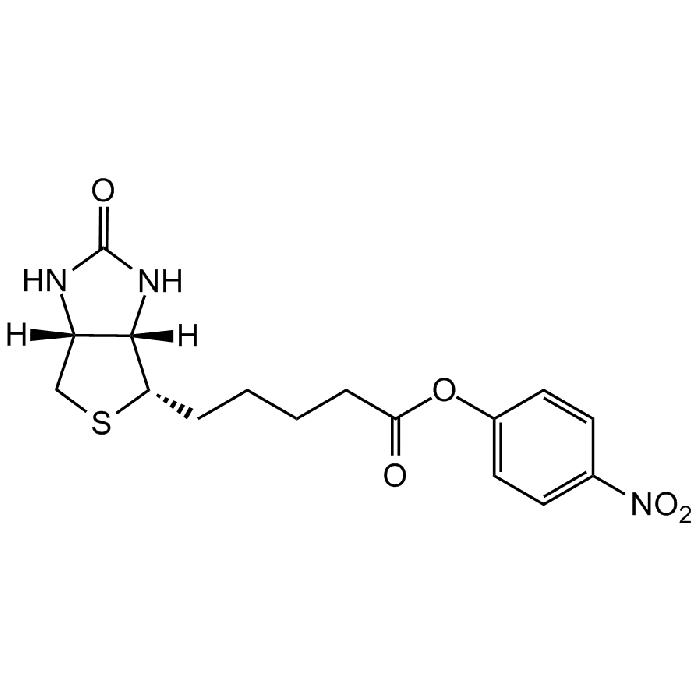Cookie Policy: This site uses cookies to improve your experience. You can find out more about our use of cookies in our Privacy Policy. By continuing to browse this site you agree to our use of cookies.
Chemodex
D-Biotin p-nitrophenyl ester

| Product Details | |
|---|---|
| Synonyms | (+)-Biotin 4-nitrophenyl ester; 4-Nitrophenyl (+)-biotinate; BNP; Biotin-ONp |
| Product Type | Chemical |
| Properties | |
| Formula |
C16H19N3O5S |
| MW | 365.4 |
| CAS | 33755-53-2 |
| Source/Host Chemicals | Synthetic |
| Purity Chemicals | ≥98% (HPLC) |
| Appearance | White to yellow powder. |
| Solubility | Soluble in methanol (25mg/ml). |
| Identity | Determined by 1H-NMR. |
| Declaration | Manufactured by Chemodex. |
| Other Product Data |
Click here for Original Manufacturer Product Datasheet |
| InChi Key | YUDNXDTXQPYKCA-YDHLFZDLSA-N |
| Smiles | O=C(OC1=CC=C([N+]([O-])=O)C=C1)CCCC[C@@H]2SC[C@@]3([H])[C@]2([H])NC(N3)=O |
| Shipping and Handling | |
| Shipping | AMBIENT |
| Short Term Storage | +4°C |
| Long Term Storage | -20°C |
| Handling Advice | Protect from light and moisture. |
| Use/Stability | Stable for at least 2 years after receipt when stored at -20°C. |
| Documents | |
| Product Specification Sheet | |
| Datasheet |
 Download PDF Download PDF |
(+)-Biotin 4-nitrophenyl ester (Biotin-ONp) is a pre-activated biotin derivative, that is used as a biotinylation reagent in the modification of peptides, amino acids and proteins. Biotin-ONp is an effective and efficient tool for the introduction of biotin during solid phase synthesis, offering greater reactivity and higher solubility than Biotin-OSu. It may also be used to prepare biotinylated quinazoline derivatives. Recently, Biotin-ONp has been described as an alkyl chain-based PROTAC linker that can be used in the synthesis of PROTACs. PROTACs contain two different ligands connected by a linker; one is a ligand for an E3 ubiquitin ligase and the other is for the target protein. PROTACs exploit the intracellular ubiquitin-proteasome system to selectively degrade target proteins.
(1) P.S. Nelson, et al.; Nucleosid. Nucleotid. 5, 233 (1986) | (2) M. Wilchek & E.A. Bayer; Meth. Enzymol. 184, 123 (1990) | (3) R.L. Geahlen, et al.; Anal. Biochem. 202, 68 (1992) | (4) B. Baumeister, et al.; Int. J. Pept. Res. Therap. 11, 139 (2005) | (5) D.F.H. Winkler & P.L. McGeer; Proteomics 8, 961 (2008) | (6) S.-Y. Seo & T.W. Corson; Meh. Enzymol. 622, 347 (2019)





